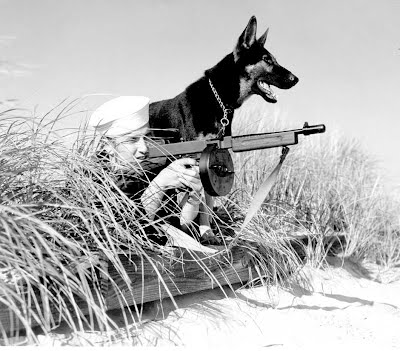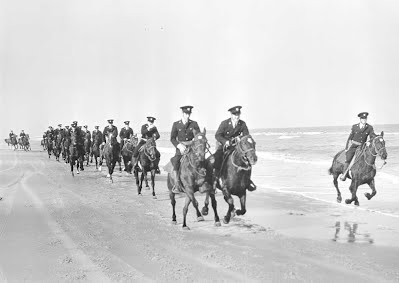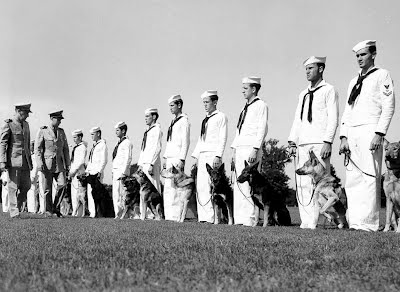Charleston Auxiliary History
By Bob Krieling, Past Flotilla Commander
The War Years
1939; It was not the best of times. A severe financial depression gripped the nation. All the military services were understaffed, equipped primarily with World War I weapons. The smallest and poorest of the lot was the Coast Guard. The Commandant of the Coast Guard, Admiral Waesche, was very aware of the problems. With sounds of war in Europe growing ever louder, he proposed to the House and Congress a plan "To enlarge the facilities of the Coast Guard without any expense whatever to the Federal Government." He proposed to recruit pleasure boaters who due to age, health, etc., were not subject to the Draft. Those magic words, "No Cost At All," sealed the deal and June 23, 1939, was the birth date of the Coast Guard Reserve.The initial mission of the Reserve was to "Assist the Coast Guard" and to take over their Safe Boating Education and Search and Rescue functions. However, within months, this mission was drastically revised. The reason for the sudden change was due to “The Miracle of Dunkirk” as the press liked to call it. Germany invaded and overran France, forcing the British Army to retreat to the beaches of Dunkirk, a French village on the English Channel. They were rescued by a "Civilian Armada" of more than 900 pleasure boaters and operators of small craft who were able to maneuver close to the shore. Working together they successfully rescued the remnants of the British Army. The media hype in this country did not go unnoticed in Washington.
On February 19, 1941, Congress changed the name to Coast Guard Auxiliary. The phrase, "Assist the Coast Guard" took on a new, far broader and more militant meaning. While the original non-military missions were continued, members and their boats recruited to actively participate in Coast Guard Patrols. Those recruited for the Coast Guard Auxiliary received instruction in First Aid, Gunnery, Navigation, Night Operations, Signaling, etc. Their pleasure boats, no longer all gleaming white with varnished teak and shining brass, were sprayed dull gray with white letters and numbers. As a boat owner, imagine how would you feel watching that being done to your pride and joy?
These men did it because it had to be done – and none too soon. German submarines were off our shores and sinking our tankers and freighters. The explosions could be seen from the shore and this rag-tag fleet of pleasure boaters took to the open seas. Small Wooden Boats – Brave, Very Brave Men.
While our country, for most of 1941, was officially at peace, the ships leaving our docks were immediately faced with a deadly foe. These unarmed freighters and tankers, laden with war supplies, were in route to England and France. They would pass by the mighty cannons of Fort Moultrie and Fort Sumter which were capable of sinking the largest battleship. The Army coast artillery, practiced daily. John Rodgers, one of our Past Flotilla Commanders, remembers watching the gun crews. They could fire over the seven-mile horizon, hit the target, reload the huge projectiles and fire again in less than a minute.
But no battleships ever came across the sea to challenge them. Instead, the enemy came like sharks beneath the sea, attacking with deadly accuracy the tonnage leaving our ports, within a few miles of our shores. Our Navy's limited assets were straining to protect these convoys at sea. They did not have ships or manpower to pursue these German "Wolf Packs" close to shore. The only defense was the Coast Guard and its newly formed Auxiliary "offspring." With limited assets, but a lot of American (notice I did not say Yankee) ingenuity, "the tough got going." This is their story and it was done in several steps.
- Prevention: Antisubmarine nets were everywhere. They were placed along our larger and even some smaller waterways. Some Charleston residents can still describe the location of these nets, placed by the Navy's Net and Boom Defense of Charleston. In fact the Post and Courier's "Do You Know Your Charleston?" column mentioned their being across the Jetties, as well as in Elliot's Cut, Edgewater Creek, Ben Sawyer Bridge and behind the Isle of Palms. Although this may sound impressive, some of the subs still got in. More about those "visitors" in our next installment.
- Rescue: As ships were being torpedoed, the seamen's only alternative was jumping into the ocean. These explosions were often seen by shore-side residents. Coast Guard and Auxiliary boats on patrol would immediately proceed to the site to rescue the survivors. The Auxiliary base on the Cooper River would also telephone those at home to respond. This procedure was enacted again and again on the entire Eastern seacoast. It was simple, it worked, and it saved lives.
- Propeller Noises Kept the Sharks At Bay: The U-boats’ sound detection devices then, unlike those of today, could not give an indication of the size of the vessel overhead. When they heard the beat of any inboard engine they lay quiet. Parallel Search Patterns became the main weapon of defense. That meant, running on a compass bearing for several miles, then turn hard right and run a shorter distance, turn hard right again, running a distance equal to the first leg. This pattern is still used today, but only for peaceful means. It is very effective in Search And Rescue work.
- Sailboats: A Secret Weapon -Submarines, sometimes called the "Silent Service," met their nemesis, a unique and even more silent weapon; the Corsair Fleet consisting of ocean going sailboats, cruising silently. They took their toll of this menace. While prop noise forced the U-boats to lay silent, the sailboat using Sonar could detect their electric motors running.
Then there came a modern twist. While not chanting old sailing ditties or yelling an, "Avast ye swabs," they did continue trailing the sub and called for a blimp (from our Navy Yard) with depth charges. Truly "Iron Men with Ships of Wood." The blimp’s mooring mast may not be there any longer. However, according to our John Rodgers, up until the time the yard was closed, you could still see it.

Dogs of War in the Coast Guard.
Centenarian Auxiliarist Honored
Welcome back, all you History buffs. There has been a slight change in plans which I think you will enjoy. I know I said in the last edition that we would focus on "The Enemy Amongst Us: Some Charleston Tourists Came by U-Boat," but that cloak and dagger stuff will keep ‘til the next edition. Today, I want to share with you the story of one of our own; a walking, talking bit of history. I want to tell you about Auxiliarist Sol A. Spiegel, a member of flotilla 32 in the Seventh District, and how he joined the Auxiliary in 1939. He was there and did it all!
The Coast Guard Seventh District, which we are part of, celebrated Sol's One Hundredth birthday at their Summer Conference. He and his wife opened the meeting by leading all in the Pledge of Allegiance. Sol, always famous for his witticisms, in his comments showed that he still had the delivery and timing of a good stand-up comic. On why he joined the Auxiliary, he said, "The height requirement to join the Services was 5'4' and I was 5'3". A Coast Guard Recruiter came to the yacht club looking for volunteers. He said, "They were looking for Small Boat Operators ... I figured I'm small, I'm an Operator, so I joined up!"
I did not of know Sol when I wrote that. However, I mentioned painting the pretty pleasure boats gray with white numbers. Sol's 30' cabin cruiser, Friminda (a combination of his mother's and wife's name) got the gray treatment with a large white 607 on the hull. This he used for submarine tracking and hunting during 1941. I mentioned Gunnery training. Sol moved up in the Reserve ranks to Chief Petty Officer and became the small arms instructor for the Coast Guard, Reserve and Women's Air Ferry Service (WAFS). That's right; they were the ladies that flew the war planes to the combat zones.
As the U-Boat menace intensified, Sol Spiegel skippered a 36' Coast Guard Patrol boat. The boat was armed with a .30 caliber machine gun. Unfortunately, he was not provided with any ammunition for the gun or a radio. Marine radios in those days were not only cumbersome; they were very scarce and limited to the dots and dashes of Morse code. In lieu of a radio (and I am not making this up), his vessel was equipped with carrier pigeons for communication. He was also provided with a handgun and six bullets "for defense." The bullets were counted at the end of each patrol.
Sol's primary duties included submarine hunting and picking up debris that could indicate cargoes and help identify vessels that had been torpedoed. As I said at the end of my first article, "Small Wooden Boats; Brave, Very Brave Men." Sol Spiegel can say with great pride, "Been There, Done ALL of That!" When the drums of war were silenced, Sol continued to actively participate in the Coast Guard Auxiliary. At the age of 80 he was one of the first to become certified under the new Coxswain Program and actively engaged in Patrols until he was 98.
Ceremonies in Washington, DC with the President and Congressmen in attendance honored Sol and other long term Auxiliarist’s. Admiral James Loy, then Commandant of the Coast Guard, shook his hand and asked him if he wished to say a few words. As only Sol can do he looked up and down at Admiral Loy, who is 6'3", turned to the audience and said, "You know, when I joined I was that tall." Give Sol an audience and he can bring down the house!

Coast Guard Calvary patrolling the Atlantic Coast.
The Enemy Among Us:
Some Tourists came by U-Boat
All in all, the Coast Guard and the Coast Guard Auxiliary, plus the Charleston citizenry were (fairly) successful in developing an effective Port Security Program. Our webmaster likes to tell about a German submarine that was captured here. On board were ticket stubs from a Charleston Theater and bread from a local bakery. His uncle was the manager of that bakery and felt the German's certainly had good taste. Communities all along the Eastern Seaboard from Maine to Florida had similar experiences. I remember reading that on Long island, NY; about 40 miles east of New York City, a team of eight saboteurs, complete with explosives shaped to look like coal, were captured the old fashioned way, by a "Coastie" and his dog. Interestingly, they were not only fluent in English but had even lived in "Noo Yawk" long enough to acquire the accent.
Similarly another spy team was captured attempting to come ashore in Florida. They too had the same accent. Yes the enemy continually sought ways and means to inflict damages to hinder the war effort. New counter-measures had to be continually devised to in order to combat them. There was no way an overall "One Size Fits All" plan could be designed. Each community had to design a security plan to fit their unique requirements. Charlestonians quickly adapted to the situation and developed their own style of protections. The citizenry responded in many ways. Jerome Bishop, one of our past Flotilla Officers, recalls how his relative, one of many, would come home, put on an Auxiliary uniform complete with side arm and patrol the miles of docks and warehouses. We already mentioned the many anti-submarine nets strung across our waterways and the "Sailboat Sub Busters", working with Navy Blimps. Now I'll add another to the list, of strange but true.

Coasties and their dogs training for beach patrols.
The photos above show the Coast Guards which trained at Hilton Head and in the Folly Beach Detachment. Old timers will recall that in the '40s, Hilton Head actually had four polo fields with stables, riding arenas, etc. During the war these were easily converted to teaching the art of Horsemanship to a bunch of sailors. It was not easy to overcome the students' attitudes, however. While they never did start to sing the Cavalry's "She wore a Yellow Ribbon," they tended to strut a bit when they wore their boots, britches and spurs that went Jingle, Jangle, and Jingle. That is the way it was. This country was united. We were all, Republicans, Democrats and Independents alike, united and determined to defeat the evil enemy.